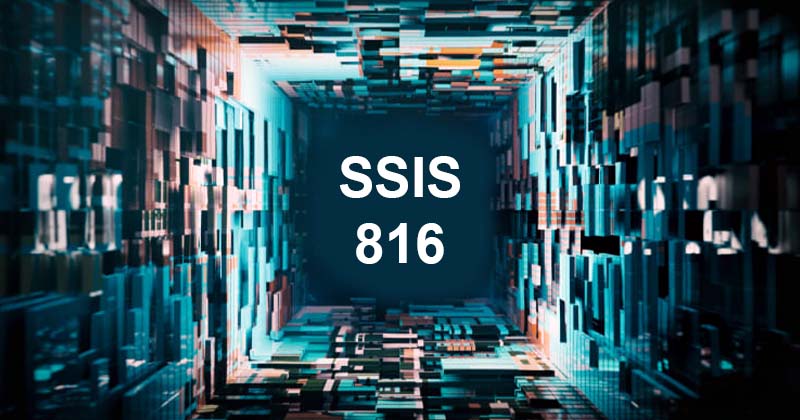Everything You Need To Know about ssis 816
As a professional in the field of data management, staying abreast of the latest technologies and tools is essential for effective job performance. Microsoft’s SQL Server Integration Services (SSIS) stands out as a prominent enterprise solution for data integration, transformation, and migration. The recent release, SQL Server Integration Services 2016 (SSIS 2016), brought forth numerous features enhancing scalability, performance, and usability. Building upon these advancements, the subsequent release, SSIS 2019, introduces additional enhancements that further amplify its capabilities.
Table of Contents
This article delves into some of the key features introduced in SSIS 2019 and elucidates how they can prove advantageous in your data integration projects. Whether you are a newcomer to SSIS or a seasoned user, a comprehensive understanding of the latest improvements in this tool is pivotal for unlocking its full potential. SSIS 2019 showcases enhancements in package management, toolbox expansion, workload scaling, and Hadoop data handling. Continue reading to gain comprehensive insights into the latest iteration of this indispensable data integration tool.
What Is SSIS 816?
SSIS 2016, denoting SQL Server Integration Services 2016, represents the latest iteration of Microsoft’s enterprise data integration platform, introduced in late 2016. This version builds upon its predecessors by enhancing performance, scalability, and user-friendliness.
Several notable features in SSIS 2016 include:
1. Azure Project Deployment: Directly deploy SSIS projects to Azure SQL Database, Azure SQL Data Warehouse, and Azure SQL Managed Instance, facilitating the migration of on-premises SSIS workloads to the cloud.
2. Incremental Package Deployment: Expedite the deployment process by redeploying only modified packages, streamlining the overall deployment workflow.
3. Data Tap: Introduce a new data tap task to effortlessly extract data from diverse sources. The tool incorporates over 70 built-in connectors, spanning social media platforms, marketing tools, and productivity applications.
4. Row Sampling Transformation: Enable the extraction of random data samples during the data flow, particularly useful for testing and profiling purposes.
5. Azure Feature Pack: Integrate additional components to connect seamlessly with Azure services such as Data Lake Store, Blob Storage, and HDInsight.
In summary, SSIS 2016 broadens integration capabilities, harnesses the potential of cloud computing, enhances developer efficiency, and elevates scalability and performance. It stands as a compelling option for organizations aiming to construct robust data integration solutions.
Key Features and Capabilities of SSIS 816
Scalability and Performance
SSIS 816 introduces advanced scalability and performance features, empowering users to scale up to 64 cores for a singular package execution, resulting in significantly enhanced data integration process performance.
The flexibility to run packages in-memory, without the need to write logs to disk, offers a performance boost. Additionally, the Scale Out feature facilitates the distribution of package execution across multiple machines, thereby enhancing overall scalability.
Advanced Data Flow Capabilities
In SSIS 816, notable improvements have been made to data flow components and transformations. The introduction of new data flow components such as the OData Source and Destination, along with the ODBC Flow Destination, expands the tool’s capabilities.
Moreover, performance enhancements have been implemented for key operations like lookups, aggregations, and pivots within the package. The update also brings about refined error handling mechanisms, featuring redirection and row-level error isolation for improved management of errors. Additionally, SSIS 816 accommodates new data types, including DATE, TIME, DATETIME2, and DATETIMEOFFSET, thereby broadening its support for diverse data structures.
Deployment and Management Improvements
SSIS 816 introduces several features aimed at enhancing deployment and management. With project deployment, entire projects can now be deployed to the SSIS catalog, extending beyond individual packages. The incorporation of parameters facilitates the runtime passing of values, enabling dynamic configuration updates.
The catalog is equipped with views for monitoring execution and validations, while new T-SQL stored procedures offer enhanced catalog management capabilities.
Overall, SSIS 816 delivers a multitude of capabilities and improvements, fostering faster, more scalable, and manageable ETL and data integration processes. Leveraging these features empowers users to construct robust and high-performing data integration solutions.
Benefits of Upgrading to SSIS 816
Benefits of Upgrading to SSIS 816
Upgrading your SQL Server Integration Services (SSIS) environment to version 816 brings about several significant advantages.
Firstly, SSIS 816 enhances security features, notably with the incorporation of Always Encrypted. This safeguard ensures the protection of sensitive data both in transit and at rest by encrypting data in the database and exclusively decrypting it within the application layer. The option for role-based security provides granular control over access to packages and their components.
Secondly, SSIS 816 introduces a modernized development experience through Visual Studio Code integration. The SSIS extension pack within Visual Studio Code offers IntelliSense, debugging, and deployment functionalities for SSIS, eliminating the need for SQL Server Data Tools (SSDT). This allows direct development of SSIS packages in Visual Studio Code, streamlining the workflow.
Additionally, SSIS 816 broadens data integration capabilities with the introduction of new connectors. Noteworthy connectors include those for SAP BW, Hadoop, and Spark, enabling seamless data transfer to/from these platforms. The OData connector facilitates data consumption from any OData v3/v4 service, while the Web connector extracts data from web pages using XPath queries.
Moreover, performance gains are achieved through scale-out functionality, enabling the distribution of package execution across multiple nodes. Running packages in-memory by loading them into the Scale Out Master eliminates the performance overhead associated with loading/unloading packages from the file system or SQL Server database.
Finally, SSIS 816 extends maintenance support for an impressive 10 years, ensuring long-term support for your data integration solutions. Regular updates and patches contribute to maximum uptime and address any potential issues.
In summary, the upgrade to SSIS 816 delivers enhanced security, a more efficient development experience, expanded connectivity options, improved performance, and a decade-long commitment to support. These benefits position the upgrade as a valuable investment for any organization reliant on robust data integration processes.
Changes and Enhancements in SSIS 816
SSIS 2016, the most recent iteration of SQL Server Integration Services, brought forth numerous changes and enhancements aimed at enhancing performance, scalability, and user-friendliness. Key improvements in SSIS 2016 encompass:
Performance and Scalability
SSIS 2016 integrates modifications geared towards enhancing both performance and scalability. The introduction of a new scale-out feature empowers the distribution of packages across multiple servers, enabling high throughput. Additionally, performance enhancements have been implemented in areas such as data flow, logging, and checkpoints.
R Integration and Advanced Analytics
Incorporating several new data mining algorithms and integration with R scripts, SSIS 2016 opens avenues for advanced analytics and predictive modeling within ETL processes. The capability to execute R scripts directly from SSIS packages and transmit data for analysis in R is now seamlessly available.
Deployment Enhancements
SSIS 2016 simplifies project deployment through the introduction of new features such as incremental package deployment, environment cloning, and project versioning. These enhancements facilitate the streamlined deployment of updates to existing projects. With the ability to deploy only the packages that have undergone changes, clone environments, and revert to previous package versions if necessary, the deployment process becomes more efficient and flexible.
Other Improvements
SSIS 2016 introduces a range of additional enhancements, including expanded connectivity to diverse data sources such as SAP HANA, Hadoop, Azure SQL Data Warehouse, and OData. It also extends support for newer versions of existing data sources, including Oracle 12c, and features an updated OLE DB provider for SQL Server. Improved logging capabilities, incorporating custom log providers, contribute to enhanced visibility. Furthermore, SSIS 2016 offers tighter integration with Power BI, enabling the initiation of Power BI reports directly from an SSIS package.
These enhancements in SSIS 2016 contribute to significant improvements in performance, scalability, and usability for ETL solutions. The increased variety of data sources, the inclusion of data mining features, and expanded deployment options provide users with greater flexibility and capability to construct sophisticated data integration projects. In summary, SSIS 2016 represents a substantial advancement, empowering the creation of higher-performing and more resilient ETL systems.
How to Get Started With SSIS 816
To get started with SQL Server Integration Services (SSIS) 2016, follow these steps:
Download and Install SSIS
To utilize SSIS, you should download SQL Server 2016, which inherently includes SSIS. The SQL Server Developer Edition, available at no cost, encompasses SSIS functionality. During the installation process of SQL Server 2016, ensure to select Integration Services as one of the features.
Launch and Explore SSIS
After installing SQL Server 2016, you can launch SSIS from the Microsoft SQL Server program group. The first time you launch SSIS, you will see the SSIS catalog, a repository for your SSIS projects. The SSIS catalog organizes your SSIS projects, environments, parameters, and logging.
Create a New SSIS Project
To initiate your initial SSIS package, begin by right-clicking on the SSIS catalog and choosing “New Folder.” Afterward, select “Project” and then opt for “Integration Services Project” as the project type. Proceed by naming your newly created project and clicking “OK” to finalize its creation. Your newly formed SSIS project will then be visible within the SSIS catalog.
Design an SSIS Package
To begin working on your new SSIS project, double-click on it to open SQL Server Data Tools (SSDT), which is the development environment for SSIS. Then, right-click on the “Packages” folder and choose “New SSIS Package” to create a new package. You can now drag and drop data flow components such as sources, transformations, and destinations onto the design surface to construct your ETL data flow.
Configure and Execute the Package
Customize the components within your SSIS package by adjusting properties and incorporating scripts or expressions as needed. Once configured, initiate the execution of your package by clicking the “Start” button or pressing F5. This action will trigger the execution of your package, causing data to seamlessly flow through the designated data flow components.
Deploy and Schedule the Package
To make your SSIS project packages available for scheduling and execution, you can deploy your project by right-clicking on it in the SSIS catalog and selecting “Deploy Project.” This action will deploy both the project and its associated packages. After deployment, you can proceed to schedule the packages for execution using SQL Server Agent or any other scheduling tool of your choice.
Following these steps will help you begin building, running, and deploying SSIS packages. If you have any further questions, feel free to ask!
Conclusion
By now, you should have developed a solid understanding of SSIS 816. With consistent practice, you will progressively enhance your ability to implement data integration solutions and manage intricate ETL processes. The key is to start with simple tasks, grasp the foundational concepts, and gradually expand your expertise through practical projects.
SSIS offers a comprehensive toolkit to empower you as a data professional. Keep yourself updated with the latest releases and features to leverage the full potential of this platform. With dedication and perseverance, you will soon automate data workflows and streamline data processing effectively. The opportunities for data integration are limitless. Now, go ahead and apply your newfound SSIS 816 skills confidently!






